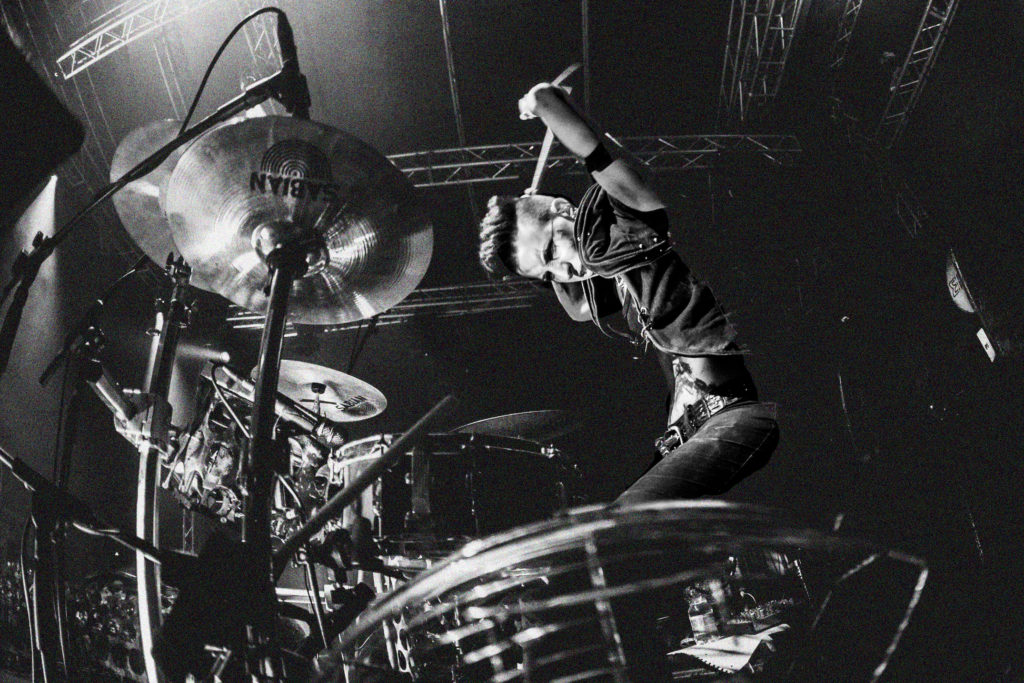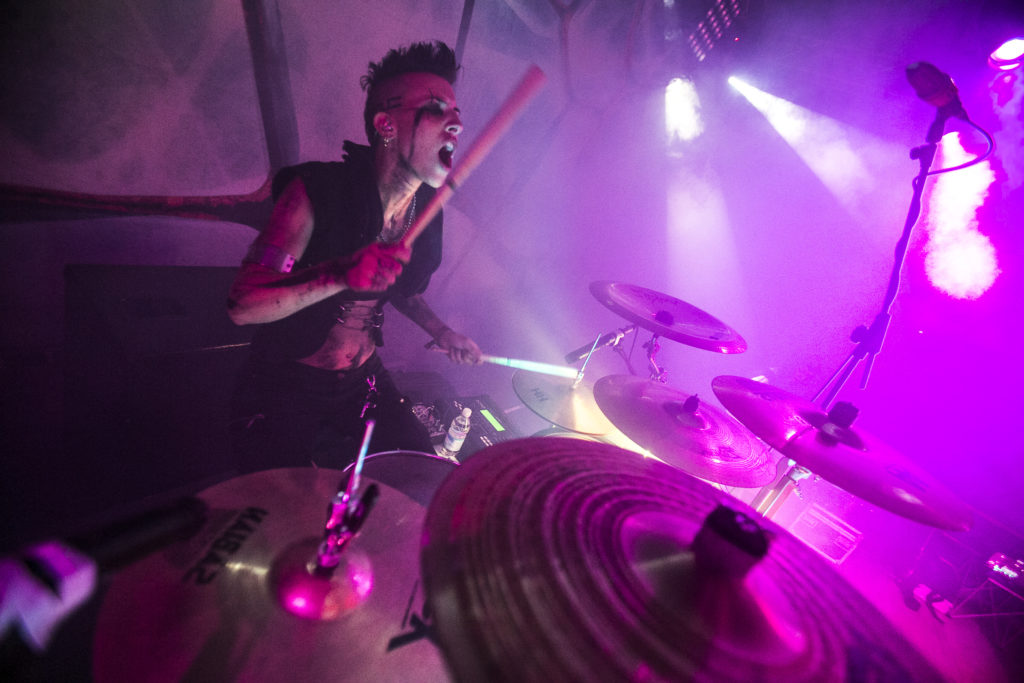Helly is an extreme metal drummer from Venice, Italy, who won the 2017 Hit Like a Girl contest in the 18+ category for her creative and intense double-bass playing to a drum remix of the God of War II video game soundtrack. While she may look as hardcore as they come in the video, in person she is one of the friendliest and most good-natured people you can imagine. Our tech editor, JJ Jones, asked Helly how she achieves her extreme bass drum speeds.
JJ: You started playing drums at age six and began studying with Sergio Pescara at age 14. When did you start playing double bass, and how did you develop your unique style?
HELLY: I started to learn double pedal at age 15 after I saw Metallica’s video for “St. Anger”! But I didn’t start really being able to play it until I was 17 years old and in the black death metal band Livyatan, my first original band. What allowed me to develop my skills has been the constant and continued will to overcome my limits. That is how I increase my endurance and speed.
As far as my style, I take inspiration from many kinds of music. Some of my ideas don’t even come from metal or rock but from electronic music. I love watching videos of drummers with completely different styles! Some of my favorites are Inferno, Terry Bozzio, Ginger Fish, and Dave Weckl. I like to have a range from one extreme to another!

In your HLAG video of the God of War II soundtrack, you’re playing 16ths at 200 bpm on the double bass. How did you get so fast?
There are no shortcuts to speed and stamina, only a lot of practice. Everyone can do it like I did—just find your big daily dose of motivation. It took me a long time (years!) to get to a good level. So my advice is to never give up, and pick up your drum sticks right now!
When I first started to use double pedal, I focused on basic exercises and the quality of the sound, since the most fundamental principle is making the volume of the right and left foot exactly the same. Only then can you think about increasing your speed or changing the exercise!
I first started to train on a classic metal double-bass groove: alternating 16th notes between the right and left feet, snare on the 2 and 4, while keeping quarter notes on a cymbal.
Then I focused on accents, which are so important for expressiveness. While keeping the same basic pattern on the double pedal and snare, I played one bar of 8th notes on a cymbal with accents on the up note, then in the next bar, accents on the down note.
The next step was to again keep the kick and snare the same, but to play 16th notes on a cymbal, moving the accent to the next 16th note in each bar: ONE-e-and-a, TWO-e-and-a, THREE-e-and-a, FOUR-e-and-a; then one-E-and-a, two-E-and-a, three-E-and-a, four-E-and-a, and so on.
That was just the beginning. Next, I restarted the whole process but changed the pattern of the double pedal. For example, instead of playing a full bar of 16th notes, I doubled the speed on the first and third quarter notes (played 32nd notes). So, the new double bass pattern was 32nd notes on the ONE, 16th notes on the TWO, 32nd notes on the THREE, and 16ths on the FOUR. I spent a long time doing this process of changing just one part of the double bass pattern.
Overall, my advice when learning double bass is: before going faster, make sure the sound and volume is equal between your right and left foot, and especially if you are playing metal or rock, be sure that you can play loud!!
TIP: “The Saver”
This warm-up exercise builds endurance and speed, trains you to achieve and maintain a high volume and is a great quick warm-up to play extremely fast: play 16th notes with your right foot very loud and in unison with your right hand for one bar, then do the same on the left for the next bar, alternating back and forth. I use the heel-up technique and keep my heel very high off the pedal. My hands are completely closed: I don’t use fingers, which means I don’t use the rebound of the stick at all: it’s just a wrist movement.
The sticks start at 90 degrees from the snare or pad with every stroke. I start the whole exercise at 160 bpm and progressively try go faster until 180 bpm, and I do this for 5 or 8 minutes until I feel warm enough. By 30 seconds in, your heart and breathing rate should increase, and if you start to feel warmer, that means you’re doing it right! A good warm-up before an intense drumming session is really important, and this exercise helps increase your speed and stamina too.
Can you talk about the bass drum pedal techniques you use and why?
The techniques I use are to ensure I get an even sound when I play fast. Just like for the hands, where your speed increases by using smaller and smaller muscle groups (arms, wrists, then fingers), the same principle applies to the bass drum: the faster you want to go, the smaller the movements of the leg, foot and ankle, and the smaller the muscle groups must be to carry out the action.
Below are my kick-pedal techniques, based on specific tempos. All use heel-up on the pedal:
Full-Leg Motion (up to 140 bpm)
In this first phase, the whole leg is used. The thigh and quadriceps have plenty of time to rise and impart a strong impulse to the pedal with the foot. This is a great technique for rock!
Medium-Leg Motion (140 to 210 bpm)
Up to 210 bpm, I still use the full leg but with smaller movements, and the toe of the foot may raise up from the pedal for a skipping motion. How far the toe raises depends on different factors: the incline and length of the pedal footboard, the length of the foot, etc.
Swivel (210 bpm and up)
Around 210 bpm and above, I use the “swivel” technique, which is what the body does organically as a movement of the ankle and the toe in order to achieve this kind of speed. For each bass drum stroke, the leg itself hardly moves, but the foot moves just slightly sideways from the ankle. One stroke is a slight movement to the right, the next stroke is a slight movement to the left—the back and forth creates the swivel. The toe never leaves the footboard because at this speed there’s no time to raise it!
To sum up pedal techniques: while increasing execution speed, the body’s approach to the pedal changes progressively. The muscular focus gradually shifts downward from the large muscles in the leg to the small muscles in the ankle, which then supports the stress of the entire execution.

Double bass requires a lot of core strength. Have you used strength training to work on your abdominal muscles, or did they just develop from playing drums?
No, I don’t do any strength training. I spend my time directly on the double bass! I was lucky, because when I was a child, I already had strong abs from playing sports, but it’s been years since I’ve done athletics. I don’t believe that working out at a gym is necessary to be a faster drummer. I’ve seen muscled guys who cannot play as fast and intense as other skinny or overweight guys. Endurance and speed are abilities that a drummer develops mainly just by sitting on the drum throne and sweating every day! Of course playing sports and working out is always a good thing, but it’s not necessary.
TIP: Precision
Helly not only has incredible speed—her drumming is extremely precise. She follows these steps when she practices:
1) Use a metronome!
2) Mic the bass drum, use in-ear monitors or headphones, and set the EQ with a lot of high frequencies in order to clearly hear the attack.
3) Watch video of performances to check body motion and listen to the recording.
The philosophy behind Helly’s system is to be extremely self-critical: never settle, notice every imperfection, correct it, and only then increase speed and/or go on to the next exercise.
It’s rare to see a female playing metal and industrial music, especially at your technical level. What drew you to this type of music? Have you experienced prejudice from other musicians for being female in such a male-dominated genre?
I’ve always been passionate about underground music, like deathcore and industrial (bands that are not played on Italian radio), and have always felt attracted to dark, violent, aggressive, chaotic, extreme, and visceral sound. Some of my favorite bands are Nine Inch Nails, Marilyn Manson, Behemoth, Rammstein, Slipknot, Slayer… And, yes, I’ve experienced prejudice by guys many times—often at metal concerts, because it’s so rare to find women who engage in extreme metal drumming! While this hasn’t discouraged me, it has become another good reason to do my best. It also means at the end of my performances, I’ve contradicted their preconceived ideas and broken the stereotype that a woman cannot play metal. I love playing metal!
JJ Jones is a Berklee trained, internationally-touring drummer and educator. She has played with folk-pop darlings Girlyman, comedian Margaret Cho, Egyptian revolutionary Ramy Essam, and LA’s riot-pop band WASI, among many others. JJ is the founder of EmpowerDrumming.com, the only drum education company in the world exclusively for women.


